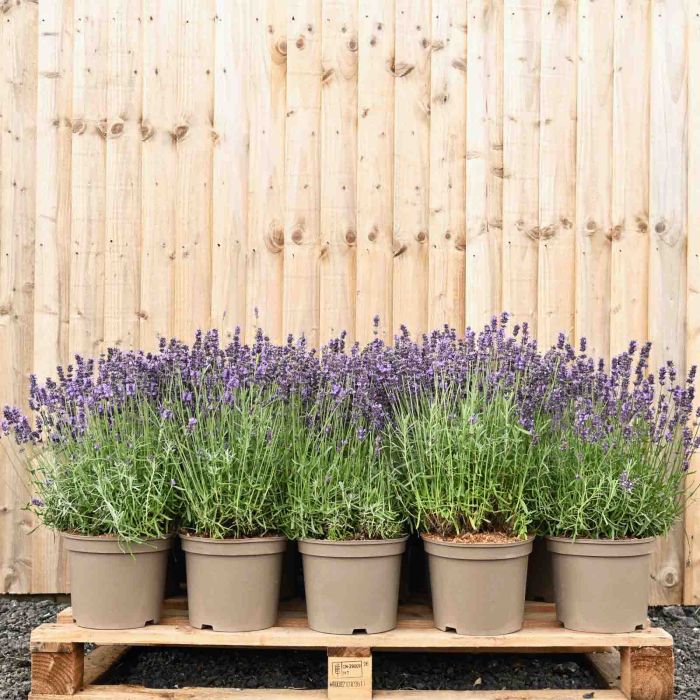
English Lavender 20/30cm 5L pot x 30 Lavandula angustifolia
In stock


Other English Lavender Hedge plants
Key Features
EVERGREEN
NATIVE
AVERAGE GROWING
HAS FLOWERS (Purple)
Seasonal Availablity
- JAN
- FEB
- MAR
- APR
- MAY
- JUN
- JUL
- AUG
- SEP
- OCT
- NOV
- DEC
Lavandula angustifolia Hedge Plant Description
An interesting fact about English Lavender plants that you might not know about. Back in the 1700s, English Lavender plants were the basis of England's lavender oil industry, and you can understand why by the fragrance this species releases. Lavandula angustifolia 'Munstead' is a traditional and favourable plant to have in the classic English cottage garden and countryside home, as it makes a stunning compact, hardy and easy to grow shrubbery hedge. Compared to the other main native, 'Hidcote' variety of Lavender from the UK, English Lavender plants have a much softer and relatively pale shade of purple flowers, with a lighter foliage colour.
The scent that is released from English Lavender plants is often used to deter pests from other host plants, including fruit trees. The flowers that produce the fragrance are unique and recognisable, and the grey/ green leaves are also aromatic.
Lavandula angustifolia 'Munstead' flowers from May/ June through to August and attracts butterflies, bees and other winged insects and pollinators, which, as a result, will also attract wild birds. It's a fabulous plant to have in the garden if you enjoy having local wildlife in your outdoor space. We recommend planting English lavender in free-draining soil, and it thrives in sunny conditions. However, please note that English Lavender plants do not tolerate shade, wet conditions, particularly with cold/ freezing temperatures or heavy soil. Some cover might be required to protect the plant over winter to ensure it remains healthy.
Being drought-tolerant, Lavandula angustifolia 'Munstead' is ideal for Mediterranean style gardens and will grow just as well in containers, planters and gravel. While English Lavender prefers sunny conditions and free-draining soil, it does make an extremely versatile addition to a garden. It looks stunning as a low-level border hedge along pathways or planting area or when planted in contrast against other brightly coloured shrubs.
Aside from the subtly sweet fragrance, English Lavender plants have many culinary uses, adding an aromatic twist to honey, biscuits, tea, cakes and even cocktails. Interestingly, Lavender can replace Rosemary in savoury dishes and the flowers are edible, imparting a sweet, citrusy flavour. It can also be quickly dried and stored for future uses.
English Lavender plants are a popular variety of Lavender hedging, but we do also have the following additional types available - Lavender 'Hidcote', French Lavender, White Lavender, and Dwarf Lavender.
Additionally we now stock a series of specially selected Lavender Collections within our Garden plants range featuring several English and French Lavender varieties plus a special mixed variety pack.
See also our range of low growing hedging plantsfor other shrubby hedge varieties.
Is English Lavender Evergreen?
All lavender varieties are technically classed as evergreen, as in warmer climates they retain their grey-green foliage year round. However, the cooler UK climate means Lavender starts to lose its flowers in August and the plants go into dormancy from early autumn until late spring. During dormancy the foliage turns brown and twiggy, appearing to die back. This is perfectly normal and as the weather warms in late spring, your Lavender plant will once again become green with new shoots.
Vital Plant Information
Reviews
Plant Guarantee
Hedges Direct always supplies quality plants, however we know that sometimes plants have a mind of their own. With the Hedges Direct Green Guarantee, we've got you covered. Our 12-month guarantee is our 100% promise to you, that you can buy with complete confidence, that if any plants fail within 12 months, we will replace them when the guarantee conditions are met.
-
Step 1
Root Grow & Fertiliser
Ensure you buy root grow and fretiliser with your plants at the time of purchase
-
Step 2
Prepare Your Planting Area
Make sure your planting area is in good condition and suitable for planting
-
Step 3
Plant & Feed
Plant with root grow & the second feed. Support plants if necessary. Water regularly
You May Need
Pruning Advice
Pruning in this way ensures that the plants have a lush, tidy appearance through winter. Once spring comes, the new shoots wil re-commence their growth giving you a dense shrub and healthy production of flowers as the weather warms.
Alternatively, you can leave the spent flower heads on the plants until spring because in winter, when food for birds is scarce, birds will come to feed on the seeds - goldfinches in particular! Plants might eventually become wooded and straggly though so it is best to replace a hedge after about 20 years although this is not always necessary.
 Hedges Direct
Hedges Direct 










